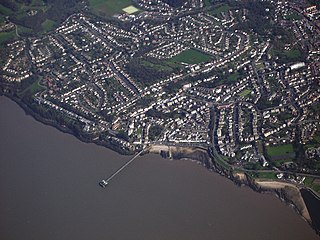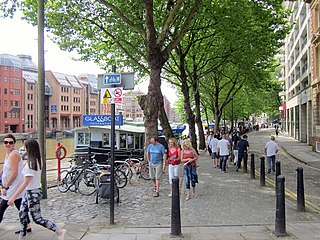
The Mabuhay Gardens, also known as The Fab Mab or The Mab, was a former San Francisco nightclub, located at 443 Broadway Street, in North Beach on the Broadway strip area best known for its striptease clubs. It closed in 1987.

Clevedon is a seaside town and civil parish in the unitary authority of North Somerset, England. It recorded a parish population of 21,281 in the United Kingdom Census 2011, estimated at 21,442 in 2019. It lies along the Severn Estuary, among small hills that include Church Hill, Wain's Hill, Dial Hill, Strawberry Hill, Castle Hill, Hangstone Hill and Court Hill, a Site of Special Scientific Interest with overlaid Pleistocene deposits. It features in the Domesday Book of 1086. Clevedon grew in the Victorian period as a seaside resort.

Redland is a neighbourhood in Bristol, England. The neighbourhood is situated between Clifton, Cotham, Bishopston and Westbury Park. The boundaries of the district are not precisely defined, but are generally taken to be Whiteladies Road in the west, the Severn Beach railway line in the south and Cranbrook Road in the east.
Wells Cathedral School is a co-educational independent day and boarding school located in Wells, Somerset, England. The school is one of the five specialist musical schools for school-age children in the United Kingdom, along with Chetham's School of Music, the Yehudi Menuhin School, the Purcell School and St. Mary's Music School, Edinburgh. The Head Master, Alastair Tighe, is a member of the Headmasters' and Headmistresses' Conference. The latest fees for day students are £9,336 – £24,558, while boarders pay £24,828 – £40,029 pa.

Bristol, the largest city in South West England, has an eclectic combination of architectural styles, ranging from the medieval to 20th century brutalism and beyond. During the mid-19th century, Bristol Byzantine, an architectural style unique to the city, was developed, and several examples have survived.

Joseph Anthony Barton is an English professional football manager and former player who played as a midfielder. Barton made 269 appearances in the Premier League, including 130 for Manchester City; he was most recently the manager of League One side Bristol Rovers.

Goldney Hall is a self-catered hall of residence in the University of Bristol. It is one of three in the Clifton area of Bristol, England.

Montpelier High School is a girls secondary Academy, located in the Montpelier area of Bristol, England. The school building was designed by William Venn Gough and dates from 1891. It uses a polychrome mix of various Northern Renaissance styles, built in red Cattybrook brick with yellow brick and buff terracotta dressings, and has been designated by English Heritage as a grade II listed building.

Cattybrook Brickpit is a 2.2-hectare (5.4-acre) geological Site of Special Scientific Interest near the village of Almondsbury, South Gloucestershire, notified in 1989. It began as a clay pit and brickworks.

Portland Square is a Grade I listed square in the St Paul's area of Bristol.

There are 100 Grade I listed buildings in Bristol, England according to Bristol City Council. The register includes many structures which for convenience are grouped together in the list below.
There are 212 Grade II* listed buildings in Bristol, England.

The Academy Cinema is a historic building on Cheltenham Road in the Stokes Croft area of Bristol, England. Since its construction in 1914, it has been used for many purposes. It is a Grade II listed building.

Berkeley Square is an area close to Park Street in the Clifton area of Bristol that includes buildings and a central area of greenery.

Bristol Byzantine is a variety of Byzantine Revival architecture that was popular in the city of Bristol from about 1850 to 1880.

The Underfall Yard is a historic boatyard on Spike Island serving Bristol Harbour in England.

A nightclub is a club that is open at night, usually for drinking, dancing and other entertainment. Nightclubs often have a bar and discothèque with a dance floor, laser lighting displays, and a stage for live music or a disc jockey (DJ) who mixes recorded music. Nightclubs tend to be smaller than live music venues like theatres and stadiums, with few or no seats for customers.
Plastic Dog was a company formed in Bristol by people affiliated with the music venues Dugout on Park Row and later the Granary nightclub. Formed by musicians, the group aimed to use their creative talents to create a bustling musical network in Bristol.

Welsh Back is a wharf and street alongside the floating harbour in the centre of the city of Bristol, England. The wharf and street extend some 450 metres (1,480 ft) along the west side of the harbour between Bristol Bridge and Redcliffe Bridge. At the northern end, the street and wharf are immediately adjacent, but to the south they are separated by a range of single story transit sheds. The wharf is a grade II listed structure and takes its name because it was freqented by vessels from Welsh ports.
















